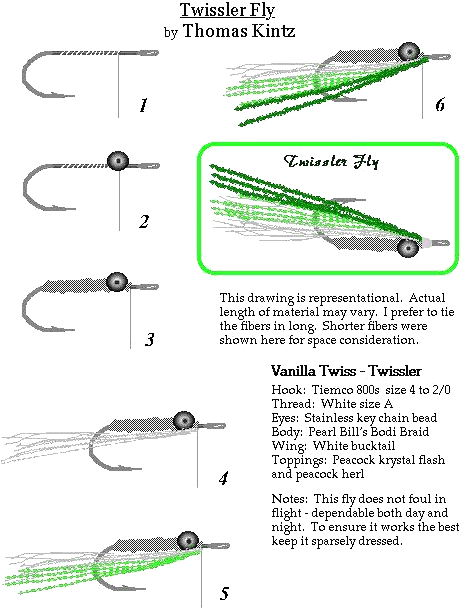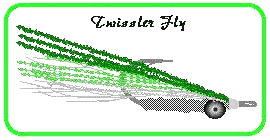Twissler
The non-fouling solution for successful New England fishing.
Here in this simple pattern is a non-fouling design
and an incredibly productive fish catcher. One of the
great features of this pattern is that the wing fibers do
not foul. Even supple flashy materials can be tied in
on the wing with confidence that it will not wrap around
the hook. Since the hook rides up in the center of the
wing, the fibers have no leverage to stay wrapped around
the hook. The popular clouser minnow, in comparison,
has a bunch of fibers tied on the shank side of the hook
which have the nasty habit of wrapping and getting caught
in the gap of the hook. This can frequently lead to a
refusal by the predator. On those windy days when the
casting may get sloppy, or at night when you count on
what you toss into the dark, it is comforting to know that
you've got a Twissler on the end.
As with other flies that ride with the point up, the
Twissler fly performs its job as weedlessly as possible.
It will also tend to ride easily over bottom obstructions.
Unless of course you are really dredging and the obstacle
is a skate or flounder, then the superior hooking action of
the fly comes into play. This fly is excellent at hooking the
fish in the upper lip where the fish will be held securely. Since
this fly catches so many fish, I prefer to crimp down the barb.
It enables me to quickly remove the fly from the fish for a
rapid release and it provides an added measure of safety in
the event I accidentally hook myself - yikes! Incidentally, I
have noticed no greater loss of hooked fish as a result of
crimping the barb, and furthermore, the lack of the barb
ensures that the fibers cannot get stuck beneath it.
The Twissler is a very simple fly to tie. The materials
are readily available, with one exception. The stainless steel
key chain bead eyes are often hard to find. Good quality fly
shops will have such material. Other eyes such as crome
plated key chain, non-toxic or lead barbell eyes may be used
with similar results, but the stainless is extremely tough while
the others may break. Although bucktail is listed in the recipes,
calf tail or craft fur may be used in small versions. Flashy
material is quite optional and definitely subject to the whim
of the tier. Feathers may also be added as well.
The Twissler Fly is a pattern which is somewhat similar
to others, most notably the Crazy Charlie. This fly is certainly
different from those commonly observed and is designed
specifically for New England fishing. This fly is so versatile it
has tremendous applications in any water, fresh or salt.

ADDITIONAL TWISSLERS
Base Model:
Hooks: Hooks: Tiemco 800s size 2/0 to 4.
Lemon Twiss
Thread: Monofilament Thread.
Body: Pearl clear.
Wing: Yellow bucktail.
Eyes: Stainless steel key chain bead.
Topping: Chartreuse Krystal Flash in large size for 1/0 and 2/0.
(Use medium size for size 2 and 4.)
Orange Twiss
Body: Bill's Bodi Braid - braided
Body: Pearl mylar in pearl or silver.
Wing: Orange bucktail
Wing: Bucktail in specific color.
Topping: Hot Orange Krystal Flash
Topping: Krystal Flash, Flashabou in specific color and sequence.
Lavender Twiss
Body: Pearl
Specifics: Wing: white, then pink, then purple.
Lime Twiss
Body: Pearl, bucktail on top.
Topping: Pearl Flashabou inserted.
Wing: Chartreuse bucktail between pink and purple bucktail.
Topping: Chartreuse Krystal Flash.
Licorice Twiss*
Body: Silver.
Wing: Black bucktail.
Topping: Black Krystal Flash or peacock herl.
Purple Twiss*
Body: Silver.
Wing: Purple bucktail.
Topping: Purple Kystal Flash or peacock herl.
* Great night/dark day flies
Anchovy Twiss
Body: Pearl.
Wing: White, then chartreuse, then blue bucktail.
Toppings: Blue pearl Krystal Flash inserted between
chartreuse and blue bucktail. Peacock herl on top.
Fishing the Fly:
The Twissler fly is very effective with any of the
various retrieve methods commonly used. It is a well
balanced fly that rides upright at any speed. A fast sweep
in a heavy current over a reef is no problem. Additionally,
the inch-by-inch retrieve performed in the shallows can be
especially deadly. Try varying the retrieve to improve your
results. Sometimes it seems that each fish wants a different
retrieve. In addition to varying the retrieve, changing the fly
color or size can be very important. Alternating the colors
after catching a few fish can give you the edge on selective
feeders. Having the extra Twissler varieties on hand is a
real confidence booster.
About Thomas Kintz
Tom is a freelance outdoor writer, avid fisherman, and
Umpqua Feather Merchants contract tyer. He
has had several of his fly patterns appear in books by Deke
Meyers, Bob Veverka, and Umpqua Feather Merchants. We
thank him for producing this fly for FAOL.
|


